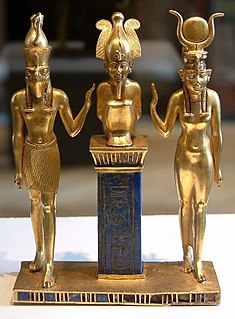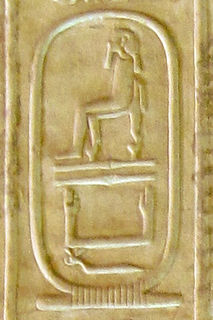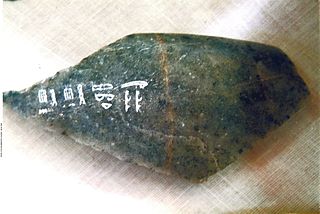| Ankhefensekhmet High Priest of Ptah in Memphis | |
|---|---|
| Predecessor | Ashakhet II |
| Successor | Shedsu-nefertum |
| Dynasty | 21st Dynasty |
| Pharaoh | Psusennes II? and Shoshenq I? |
| Father | Ashakhet II |
| Wife | Tapeshenese, First Chief of the Harem of Ptah and Prophetess of Mut |
| Children | Shedsu-nefertum |
| Ankhefensekhmet in hieroglyphs |
|---|
Ankhefensekhmet(ˁnḫ=f n sḫm.t; "He lives for Sekhmet" [1] ) was a High Priest of Ptah during the 21st Dynasty. He probably served during the reign of Psusennes II and maybe the reign of Shoshenq I.
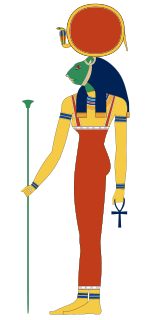
In Egyptian mythology, Sekhmet, also spelled Sakhmet, Sekhet, or Sakhet, among other spellings, is a warrior goddess as well as goddess of healing. She is depicted as a lioness, the fiercest hunter known to the Egyptians. It was said that her breath formed the desert. She was seen as the protector of the pharaohs and led them in warfare.

The High Priest of Ptah was sometimes referred to as "The Greatest of the Directors of Craftsmanship" (wr-ḫrp-ḥmwt). This title refers to Ptah as the patron god of the craftsmen.

Titkheperure or Tyetkheperre Psusennes II [Greek Ψουσέννης] or Hor-Pasebakhaenniut II [Egyptian ḥr-p3-sb3-ḫˁỉ-<n>-nỉwt], was the last king of the Twenty-first dynasty of Egypt. His royal name means "Image of the transformations of Re" in Egyptian. Psusennes II is often considered the same person as the High-Priest of Amun known as Psusennes III. The Egyptologist Karl Jansen-Winkeln notes that an important graffito from the Temple of Abydos contains the complete titles of a king Tyetkheperre Setepenre Pasebakhaenniut Meryamun "who is simultaneously called the HPA and supreme military commander." This suggests that Psusennes was both king at Tanis and the High Priest in Thebes at the same time, meaning he did not resign his office as High Priest of Amun during his reign. The few contemporary attestations from his reign include the aforementioned graffito in Seti I's Abydos temple, an ostracon from Umm el-Qa'ab, an affiliation at Karnak and his presumed burial – which consists of a gilded coffin with a royal uraeus and a Mummy, found in an antechamber of Psusennes I's tomb at Tanis. He was a High Priest of Amun at Thebes and the son of Pinedjem II and Istemkheb. His daughter Maatkare B was the Great Royal Wife of Osorkon I.
Ankhefensekhmet is known from a genealogy known as Berlin 23673, which was made by his namesake descendant during the late 22nd Dynasty. On it, he is said to be a prophet (hm nTr). He is also mentioned in a genealogy from the Louvre where he is said to be a High Priest of Ptah.

The Genealogy of Ankhefensekhmet or Genealogy of the Memphite priestly elite is an ancient Egyptian relief – sometimes referred as a stela – made during the 8th century BCE, under the reign of pharaoh Shoshenq V of the late 22nd Dynasty. A surviving block is kept at the Egyptian Museum of Berlin. The relief was issued by a priest called Ankhefensekhmet with the purpose of illustrating his own genealogy. The relief traces back Ankhefensekhmet's sequence of ancestors up to 60 generations before, with the earliest individuals dating back to the 11th Dynasty.
Ankhefensekhmet is known to have married the Lady Tapeshenese, who served as the First Chief of the Harem of Ptah and Prophetess of Mut. She was the mother of his successor Shedsu-nefertum. [2]

In Egyptian mythology, Ptah is the demiurge of Memphis, god of craftsmen and architects. In the triad of Memphis, he is the husband of Sekhmet and the father of Nefertum. He was also regarded as the father of the sage Imhotep.
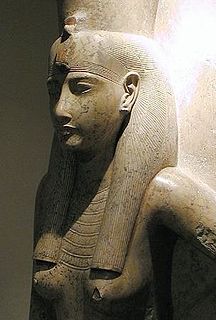
Mut, which meant mother in the ancient Egyptian language, was an ancient Egyptian mother goddess with multiple aspects that changed over the thousands of years of the culture. Alternative spellings are Maut and Mout. She was considered a primal deity, associated with the waters from which everything was born through parthenogenesis. She also was depicted as a woman with a head dress. The rulers of Egypt each supported her worship in their own way to emphasize their own authority and right to rule through an association with Mut.

Shedsu-nefertum was a High Priest of Ptah at the end of the 21st dynasty and beginning of the 22nd dynasty. Shedsunefertem was the son of the High Priest Ankhefensekhmet and the lady Tapeshenese, who was First Chief of the Harem of Ptah and Prophetess of Mut.


